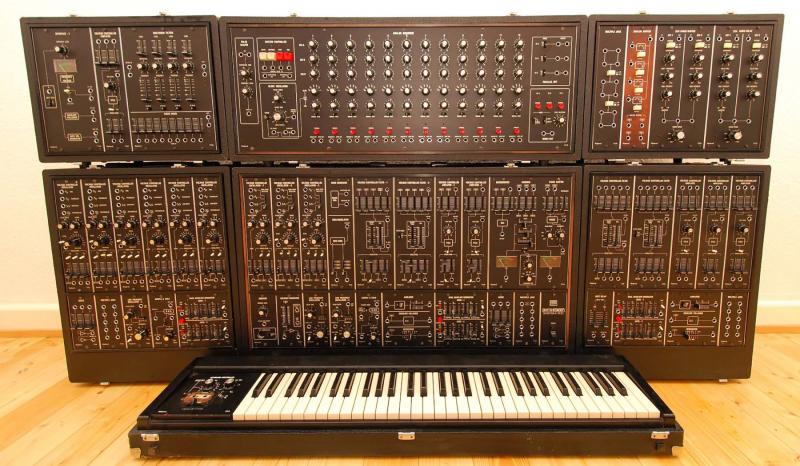Filter on ALL, SYNTH, DRUM, SAMPLER or MISC |
Total list currently 2405 items in 330 Brands |
Roland | System 700 |
Description | The System 700 was a great big modular analog synthesizer system from Roland. A major player in the modular synth market, it competed against monsters like the Moog Modulars and the ARP 2500 & 2600. A very fat sounding synth. Incredible flexibility and great sound and design. Unfortunately this synth requires a lot of knowledge about synthesis and signal flow in order to maximize its full potential. Truly a professional instrument, even by today's standards! The System 700 consists of the Main Console (pictured center), the Keyboard Controller, and five optional "blocks" (pictured above surrounding Main Console). A complete system as pictured above has a total of 47 modules (see Tech. Specs for modules info). Most System 700s were sold in the following configuration blocks: "Block 1" (Main Console): This is the Heart of the System, and it contains all the basic modules necessary for a professional system. It has 3 VCOs, 2 VCFs, 2 VCAs, 2 LFOs, 2 ADSR egs, Noise, Ring Mod, Voltage Processor, S/H, Envelope Follower, "Integrater" (Lag Processor), Mixer, 2 X 5 multiples, Headphone Monitor Module, and an Output Module, which includes Stereo VUs, a six-position test-tone, Phase Shifter, Spring Reverb, and voltage controlled Panning. Most common module connections (power, cv, gate) are made internally for easier patching. "Block 2" (Keyboard Controller): The 61-key two-voice Keyboard with Portamento and Pitchbend controls. "Block 3" (Sequencer): a 3 X 12 step sequencer with Pulse Shaper, Clock Oscillator, and Series / Parallel output sections. "Block 4" (VCO Bank): 6 VCOs, a dual ADSR envelope generator, LFO, Sample and Hold, 2 X 5 Multiples, and a small Mixer. "Block 5" (VCF/VCA Bank): 2 VCFs, 3 VCAs, 2 dual ADSR envelope generators, 2 X 5 Multiples, and a Gate Delay. "Block 6" (Interface/Mixer): a Frequency-to-Voltage Converter Interface, a VCA, 9-channel Audio Mixer, and a Fixed Filter Bank. "Block 7" (Phase Shifter/Audio Delay): a 2-channel Phase Shifter and a 2-channel Audio Delay, 4 input Analog Switch, and a (1X12, 1X4, 1X8, 3X4) multiple. Blocks 3 through 7 were options and could be arranged by the original owners in any way. Roland also released a Lab version, the "Laboratory System 700", the size of one lower wing cabinet with 3 VCOs, ring mod, VCA, mixer, LFO, Sample & Hold, Dual Envelope Generator, and VCF. Full Systems can cost as much as $18,000 and the Lab System is between $3,500 to $4,000! Roland was initially reluctant to sell individual modules to end users, which inhibited sales, and the line was somewhat undercut by Roland's own introduction of the less expensive System 100m in 1979. Nearly all units sold had been scrapped, or stored and forgotten about, by 1995, and it appeared that the type might be lost to history before some collectors made an effort to locate and restore a few systems in the 2000s. Working systems are rare enough, and so seldom come up for sale, that assigning a collection value now is difficult. One aspect of keeping a System 700 working is the oddball and rather difficult power supply voltage; it requires +/- 23 volts, higher than most synths and high enough that some care has to be taken in cabling and connectors. |
| Brand | Roland |
| Model | System 700 |
| Device | Synth |
| Type | Keys |
| Engine Type | Modular |
| Engine | VCO |
| Voices (max) | 1 |
| LFO | 706A,B: LFOs (rate/delay). 709A,B: Sample & Hold Modules. |
| Engine Detailed | 702A,B,C,D,E: VCOs with four waveforms (sine, triangle, sawtooth, and rectangle), PWM, and range knobs (LO to 2'), and a pitch control (+-12 semi-tones). 702A: has a PWM input and slider, and LFO1 mod input is hard-wired. 702B: has a hard-wired ADSR1 and LFO1 modulation inputs and sync. 702C: has a Sample & Hold and LFO1 input and sync. 702D: like A but with a socket instead of hard-wired mod inputs. 702E: like B&C without the hard-wired inputs. 708A: Noise and Ring Modulators. |
| Filter (VCF) | 703B,C,D: 12dB VCFs. 703E,F: 24dB VCFs. 715A: Multimode Filter, Mixer. |
| Envelope (VCA) | 704A,B,C,D: VCAs. 705A: Dual Envelopes. 707A: Envelope Follower. |
| FX | 720B: 2-channel Phase Shifter. 721B: 2-channel Audio Delay. |
| Arpeggiator | 717A: Analog Sequencer |
| Keys | 61 |
| Key type | 701A: 5-octave 61-note keyboard |
| Velocity | N |
| Aftertouch | N |
| CV-gate | 712A: CV Processor. 713A: Gate Delay. |
| Extra info | 710A,B: Multiples. 711A: Output module (Stereo VUs, a six-position test-tone, a Phase Shifter, a Spring Reverb, and voltage-controlled Panning). 714B: Frequency-to-Voltage Converter, Envelope Follower. 716A: Mixer. 718A: Power Supply. 723A: Analog Switch. |
| Produced: | 1976 - 1982 |
| Legend: | Obvious | Y: Yes, N: No, N/A: Not Applicable | |
| VCO | Voltage Controlled Oscillator | DCO | Digital Controlled Oscillator |
| LFO | Low Frequency Oscillator | Sub | Sub Oscillator |
| VCF | Voltage Controlled Filter | VCA | Voltage Controlled Amplifier |
| Velocity | As with a piano, the harder you hit a key, the louder the sound, unlike most organs which always produce the same loudness no matter how hard you hit a key. | Aftertouch | Pressing a key after you activated it. Channel Aftertouch, no matter which key, it will send a Channel message. Poly Aftertouch, sends the pressure per key instead of the whole channel. |
| Values for OSC, LFO, Filter, Envelope are per voice unless stated otherwise. | |||



